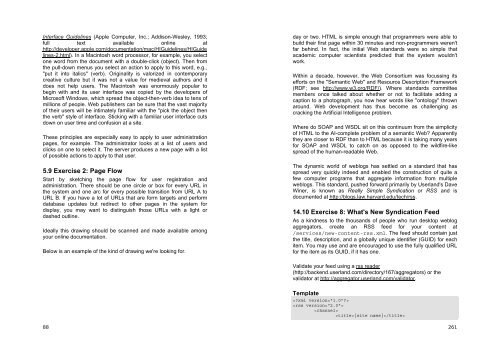Software Engineering for Internet Applications - Student Community
Software Engineering for Internet Applications - Student Community
Software Engineering for Internet Applications - Student Community
Create successful ePaper yourself
Turn your PDF publications into a flip-book with our unique Google optimized e-Paper software.
Interface Guidelines (Apple Computer, Inc.; Addison-Wesley, 1993;full text available online athttp://developer.apple.com/documentation/mac/HIGuidelines/HIGuidelines-2.html). In a Macintosh word processor, <strong>for</strong> example, you selectone word from the document with a double-click (object). Then fromthe pull-down menus you select an action to apply to this word, e.g.,"put it into italics" (verb). Originality is valorized in contemporarycreative culture but it was not a value <strong>for</strong> medieval authors and itdoes not help users. The Macintosh was enormously popular tobegin with and its user interface was copied by the developers ofMicrosoft Windows, which spread the object-then-verb idea to tens ofmillions of people. Web publishers can be sure that the vast majorityof their users will be intimately familiar with the "pick the object thenthe verb" style of interface. Sticking with a familiar user interface cutsdown on user time and confusion at a site.These principles are especially easy to apply to user administrationpages, <strong>for</strong> example. The administrator looks at a list of users andclicks on one to select it. The server produces a new page with a listof possible actions to apply to that user.5.9 Exercise 2: Page FlowStart by sketching the page flow <strong>for</strong> user registration andadministration. There should be one circle or box <strong>for</strong> every URL inthe system and one arc <strong>for</strong> every possible transition from URL A toURL B. If you have a lot of URLs that are <strong>for</strong>m targets and per<strong>for</strong>mdatabase updates but redirect to other pages in the system <strong>for</strong>display, you may want to distinguish those URLs with a light ordashed outline.Ideally this drawing should be scanned and made available amongyour online documentation.Below is an example of the kind of drawing we're looking <strong>for</strong>.day or two. HTML is simple enough that programmers were able tobuild their first page within 30 minutes and non-programmers weren'tfar behind. In fact, the initial Web standards were so simple thatacademic computer scientists predicted that the system wouldn'twork.Within a decade, however, the Web Consortium was focussing itsef<strong>for</strong>ts on the "Semantic Web" and Resource Description Framework(RDF; see http://www.w3.org/RDF/). Where standards committeemembers once talked about whether or not to facilitate adding acaption to a photograph, you now hear words like "ontology" thrownaround. Web development has thus become as challenging ascracking the Artificial Intelligence problem.Where do SOAP and WSDL sit on this continuum from the simplicityof HTML to the AI-complete problem of a semantic Web? Apparentlythey are closer to RDF than to HTML because it is taking many years<strong>for</strong> SOAP and WSDL to catch on as opposed to the wildfire-likespread of the human-readable Web.The dynamic world of weblogs has settled on a standard that hasspread very quickly indeed and enabled the construction of quite afew computer programs that aggregate in<strong>for</strong>mation from multipleweblogs. This standard, pushed <strong>for</strong>ward primarily by Userland's DaveWiner, is known as Really Simple Syndication or RSS and isdocumented at http://blogs.law.harvard.edu/tech/rss.14.10 Exercise 8: What's New Syndication FeedAs a kindness to the thousands of people who run desktop weblogaggregators, create an RSS feed <strong>for</strong> your content at/services/new-content-rss.xml. The feed should contain justthe title, description, and a globally unique identifier (GUID) <strong>for</strong> eachitem. You may use and are encouraged to use the fully qualified URL<strong>for</strong> the item as its GUID, if it has one.Validate your feed using a rss reader(http://backend.userland.com/directory/167/aggregators) or thevalidator at http://aggregator.userland.com/validator.Template{site name}88261








![Slide Kuliah PBO [1]](https://img.yumpu.com/50749096/1/190x245/slide-kuliah-pbo-1.jpg?quality=85)





![Slide Kuliah PBO [1]](https://img.yumpu.com/49268027/1/190x245/slide-kuliah-pbo-1.jpg?quality=85)

